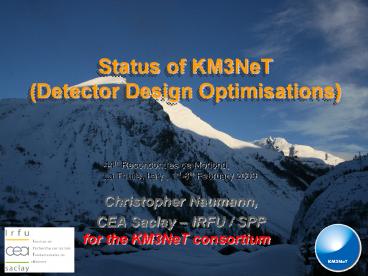Status of KM3NeT (Detector Design Optimisations) PowerPoint PPT Presentation
Title: Status of KM3NeT (Detector Design Optimisations)
1
Status of KM3NeT(Detector Design Optimisations)
44th Reconcontres de Moriond, La Thuile, Italy ,
1st-8th February 2009
- Christopher Naumann,
- CEA Saclay IRFU / SPPfor the KM3NeT consortium
2
Physics Motivation Neutrinos from Astrophysical
Sources
- TeV neutrinos by-product in cosmic accelerators
p/A p/g ? p? ... ?
nm m ? nm ne e
- smoking gun for hadronic acceleration
- probe for hidden sources no magnetic
deflection, (nearly) no absorption - ?new window to astrophysics!
3
Existing Neutrino Telescopes
- Lake Baikal, Siberia
- Baikal Deep Underwater Neutrino Telescope (1993)
- South Pole
- AMANDA (1996)
- IceCube (2005)under construction,first km3
size detector
- Mediterranean
- ANTARES (completed summer 2008)
- RD project NEMO, NESTOR
- no km3 sized detector in the North !
4
KM3NeT a km3 neutrino telescope in the
Mediterranean
- Consortium of 40 laboratories from 10 European
countries - Combines Mediterranean projects ANTARES, NEMO and
NESTOR - ? neutrino astronomy on a new scale earth and
sea science
co-financed by E.U. (FP6 and FP7)
- Design Study (2006-2009) develop a
cost-effective design for the construction of a 1
km3 neutrino telescope - Preparatory Phase (2008-2011) prepararation for
construction by defining the legal, financial and
governance issues, as well as the pre-production
of the telescope components
5
The KM3NeT site
three candidate sites in the Mediterranean depth
2500-5500 m different water properties decision
pending
KM3NeT
sky coverage gt 2p sr complementary to IceCube
(but overlap) Galactic centre HESS sources
6
KM3NeT Design Goals
- complementary to IceCube and with improved
physics sensitivity - angular resolution 0.1 above 30TeV
- focus energy range 1 TeV 1 PeV
- good muon background suppression
ISBN 978-90-6488-031-5
- need O(104) optical modules, instrumented volume
O(1km3) (50 ANTARES).
physics simulation information tech. hardware
development risk assessment deep sea
infrastructure associated science management
design goals and technical options formulated in
CDR www.km3net.org/CDR/CDR-KM3NeT.pdf
7
Neutrino Telescope Detection Principle
3D PMT array
reconstruct muon (neutrino) trajectory from
position and timing of hits
Cherenkov light from ?
42
sea floor
?
efficiency and quality depend strongly on PMT
distribution !
interaction
?
8
Geometry optimisation studies
Detector optimisation a multidimensional problem
!
sea floor layout
readout data flow
trigger, reconstruction
- find detector which is
- optimised for physics goals
- technically and financially feasible
- can be built on short time scale!
type of detection units
detector site (water properties, depth)
- physics neutrinos, atmospheric m, optical
background - hardware detector characteristics, water
properties - use return of experience from ANTARES, NEMO and
NESTOR!
9
Optimisation Possible detector layouts
- square / hexagonal grids, rings, clusters
- large range of horizontal and vertical distances
- None ideal for all energies and directions
- optimum distances ? energy range, site
- optimisation ongoing !
10
Optimisation Detection Units
- investigate different types of detection units
- strings (1D) or towers (3D)
- single large or many small PMTs
- directional PMTs, hybrid photodetectors,
? affect detector characteristics! ? included in
simulation
multi-PMT
directional PMT
hybrid PD
large PMT
11
Example results Reference detector (CDR)
representative detector designbasis for
sensitivity studies NOT the final KM3NeT design!
- Geometry string type
- 15 x 15 strings, rectangular grid, horizontal
distances 95 m - 37 storeys, distance 15.5m
- storey single OM with 21 3 PMTs
neutrino effective area (defines event rate) 30
ANTARES !
12
Point source limits, reference detector
- point source limits
- source flux E-2
- backgroundatmospheric n only
- 90 CL
- Tmeas 1 year
preliminary!
x 30
limits better than ANTARES and IceCubebetter
angular resolution and larger photocathode area ?
within reach of model predictions for several
known CR sources !
13
Diffuse fluxes, reference detector
- diffuse flux sensitivity
- spectrum E-2
- only nm CC
- MC energy
atmospheric flux (Bartol)
ANTARES
W-B
IceCube
KM3NeT
factor 10 below Waxman-Bahcall bound ? reach
area interesting for neutrino searches!
14
Dark matter sensitivity (reference detector)
Scan of mSUGRAparameter space Focus on
pointscompatible withWMAP data
- Detectability
- Blue ANTARES
- Green KM3NeT
- Red None of them
significant increase over ANTARES sensitivity
preliminary values, need for further optimisation
!
15
Conclusions and Outlook
- KM3NeT consortium in the process of designing a
km3 size detector for the Mediterranean - large number of options for layout and technology
studied, narrowing parameter space down - first values for sensitivity (non-optimised)
- ? Conceptual Design Report ready (April 2008)
- Next step Finalisation of storey and detector
layout - ?Technical Design Report (TDR) end of 2009
- construction of working prototypes
- Start of construction foreseen 2011
Thank you !
16
Back-Up
17
Current Situation
The universe in TeV neutrinos as of February 2009
?
Its high time to change this !
18
KM3NeT and IceCube
- Southern Hemisphere
- South Pole ice
- no optical background
- long absorption length
- shorter scattering length
low E threshold
limited angular resolution
complementary sky coverage
- Northern Hemisphere
- Sea water
- optical background
- shorter absorption length
- long scattering length
higher E threshold
better angular resolution

